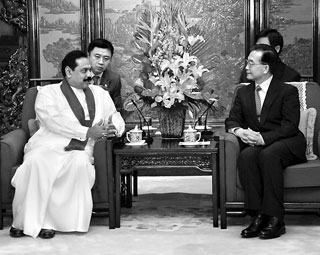Those who have monitored the recent coverage in the western media of developments in Sri Lanka would have observed the increasing finger-pointing at China for Sri Lanka’s military defeat of the LTTE.
The western media have found the Sri Lanka conflict and its aftermath a convenient peg on which to hang their concerns over China’s diplomatic success in strengthening relations with nations in Asia and Africa while western influence in this part of the world appears to be waning.
In the coming months western criticism of China is bound to gain in stridency as governments, media and NGOs join hands to condemn China for lending diplomatic cover to those perceived as violating human rights when their real worry is geopolitical and geostrategic concerns.
 |
| President Mahinda Rajapaksa with Chinese Premier Wen Jiabao during a state visit to China in 2007 |
The tone is going to be shriller especially now that the European Union- led attempt to condemn Sri Lanka for human rights violations suffered an ignominious defeat at the Human Rights Council in Geneva a few days ago. China, among others defied the EU and supported the Sri Lanka- sponsored resolution that won an impressive majority because of clever and sustained diplomacy by Colombo and Geneva that overcame the overbearing efforts of the European Union. It is China’s growing diplomatic and economic clout challenging the former western colonial powers who have held sway over their historical hunting grounds in the southern hemisphere that they find unacceptable.
So, as western hegemony is challenged the media and western-funded INGOs in the guise of universal defenders of human rights turn the spotlight on those who are responsible for eroding western supremacy instead of the much-needed introspection that would show their governments are hardly an attar of roses.
Since the current challenge to the West in this part of the world is coming from China, Beijing is being portrayed as the villain of the piece for providing the military hardware that helped defeat the LTTE. Such facile criticism disguised as punditry ignores, deliberately or otherwise, several factors that could easily have been checked if these media persons and their kindred souls had done what elementary journalistic practice should have taught them early in their careers.
Sri Lanka purchasing weapons and munitions from China is nothing new. In fact it has been going on for years. China’s Peoples’ Liberation Army (PLA) actually had a weapons sales agency called Norinco that had an office in Hong Kong even during the British administration of that colony. After the 1971 JVP insurrection, the then government of Prime Minister Sirima Bandaranaike purchased weapons from China to meet security needs. It does not need a doctorate in international relations from Oxbridge to know that Sino-Lanka relations have grown steadily since this country, then called Ceylon, diplomatically recognized the Peoples’ Republic of China in 1950 and established diplomatic missions in the respective capitals in 1957.
Perhaps the one single act early in the Sino-Lanka relationship that endeared the new revolutionary China to our country was that of the then UNP government which provided Ceylon rubber to China at the height of the Korean War. The supply of rubber to China was embargoed by the United States which feared that the availability of rubber would feed the burgeoning war machine of China which had entered the Korean War on the side of the North. What is significant is that the rightwing UNP government of the day whose foreign policy was so obviously pro-western decided to defy the mighty United States that threatened to stop aid to Colombo, and sign a trade pact with China. This deal which came to be popularly known as the Rubber-Rice Pact sealed in 1952 endured for 25 year or more.
The truth is that over the years a bipartisan policy on China evolved and on matters of crucial importance to China such as its sovereignty over Taiwan and Tibet, Sri Lanka’s position was steadfast. Sri Lanka’s one-China policy has stood the test of time. With the UNP’s recognition of China in 1950 it was the 1952 Rubber-Rice Pact that laid the critical foundation on which the Bandaranaikes built the strong edifice of Sino-Lanka relations, cemented particularly with Mrs Bandaranaike’s strong commitment to Non-alignment and her then opposition to the US/UK base in Diego Garcia which led her to propose at the UN the declaration of the Indian Ocean as a Peace Zone.
What seems to stick in the craw of western governments and the media today is that their infallible prognostications and theories on counter-insurgency have come badly unstuck. The western know-alls including some Colombo-based diplomats and their NGO cohorts had long predicted the military invincibility of the LTTE. It was claimed with condescending hauteur that Sri Lankans who thought the LTTE could be defeated on the battlefield were living in cuckooland.
The most they would concede is that if the government cannot win the war neither could the LTTE. Having had their myths shattered and their expertise exposed, the media-led argument is that Sri Lanka owes its military victory to Chinese weaponry.
While not decrying the importance of the military materiel the argument fails to explain why the US/UK with even more sophisticated arms and technologically-advanced equipment could not quell the fighting in Iraq or decimate the rag-tag al Qaeda or a somewhat more organized and better equipped Taliban in Afghanistan. If weaponry was the sole reason then the US would not have to pour in more troops into Afghanistan to curb a Mujahedin that the Americans created in the first place to fight Moscow.
The media and others also blithely ignore the fact that it is because the US stopped arms supplies and India refused to supply offensive weapons after a wish list was submitted, that Sri Lanka turned to China. But they see the development of a sea port in Hambantota as the quid pro quo for China’s generosity. |

